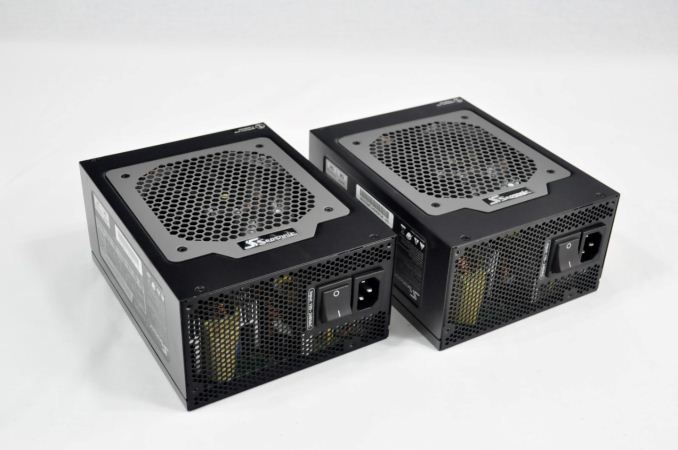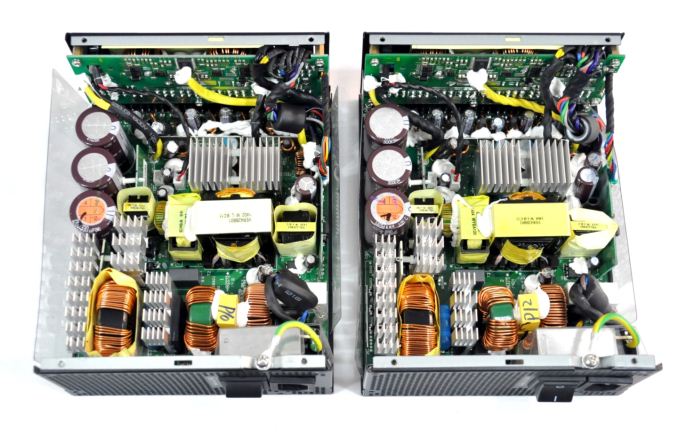Seasonic Platinum SS-1050XP3 & SS-1200XP3 Power Supply Review
by E. Fylladitakis on September 3, 2014 6:00 PM EST- Posted in
- Cases/Cooling/PSUs
- Seasonic
- 1200W
- 80Plus Platinum
- 1050W
External Appearance
Externally, both units are nearly identical, with the sole exception being the sticker with the specifications table on the left side of the chassis. The 190mm long chassis will most likely be too long for small cases, but these units are definitely not designed for compact systems. Seasonic's designs usually are subtle but the company has performed several modifications to enhance the aesthetic value of their top-tier units.
The circular fan guard has been replaced with a rectangular grey panel, with a honeycomb mesh pattern and a badge with the company logo on it. Seasonic added decorative engravings and printed the company and series logos on the right side of the chassis, where they will most likely be invisible, as they will be facing the right side panel of most cases. For these engravings to be visible from a windowed left side panel, the PSU will have to be installed with the fan facing upwards. If the fan is facing downwards, the decorations will also be upside down, so they are best left out of sight. On the left side of the chassis, the side that is visible from windowed side panels, Seasonic placed a sticker with the specifications of the PSU.
A typical C14 receptacle can be seen at the perforated rear side of the units, next to a large on/off switch. The front of the units is filled with connectors for the modular cables and there also is a switch that can change the fan's profile from normal to hybrid mode. The hybrid mode is a quieter thermal profile and allows the fan to be turned off entirely when it's not necessary. Finally, the company and series logos are printed here as well.
Internal Design
Seasonic went with a San Ace 9S1212H403 120mm fan in both of their newest models. It is a very powerful fan, with a top rated speed of 2700RPM. The specifications of the bearing/engine are not available from the manufacturer, but it looks like Sanyo uses a form of self-lubricating sleeve bearing. The life expectancy of this fan is 40,000 hours, a rather mediocre rating for similar devices, but it also translates to about 4.5 years of 24/7 use at 60°C, albeit this rating also is for a free, unobstructed air path (zero static pressure, max airflow).
Seasonic designs and builds their own units so there is no secondary / hidden OEM behind their Platinum series; these PSUs are entirely in-house productions. Both units share the exact same platform and design, with the obvious difference being only the ratings of both the passive and active components. For example, the 1050W version has three Nippon Chemi-Con 330μF capacitors at the PFC stage, whereas the 1200W version has three 390μF capacitors of the same type installed there. Aside from the component ratings however, the two versions do not have a discernible design difference.
The filtering components at the back of the AC receptacle are shielded in an effort to reduce EMI. The total number of filtering components is six Y capacitors, four X capacitors, and three filtering inductors, more than adequate for a strong filtering stage, even for units of this size. Moving towards the APFC stage, we can see the two bridge rectifiers on their own small heatsink, followed by a sizable APFC coil and three capacitors from Nippon Chemi-Con.
The active PFC components are on the long heatsink near the edge of the PCB, while the smaller heatsink towards the center of the unit holds the four transistors that form the full-bridge inversion stage. Two square heatsinks cool the active components of the secondary conversion stage, which are not directly attached to the heatsinks but are on the rear of the PCB. Nippon Chemi-Con supplies all of the secondary side capacitors as well, electrolytic and solid alike, making these units an all-Japanese affair.
When it comes to build quality, Seasonic has an excellent reputation for designing and building top-quality products; these two units however surprised us. Seasonic is definitely using top-tier components, some of the best that can be found in a consumer-grade product. The soldering job is excellent as well and we could not find a single bad joint or weak point. What confounded us however is that the assembly of the Platinum units is rather messy, which is a first for Seasonic.
It is not bad, not even average, but it does not live up to the standards Seasonic themselves have set. There are cables pressing against components and many electrolytic capacitors appear to have received mechanical force after they have been soldered on the board, tilting them left and right. Even the glue appears to have been spilt carelessly and purposelessly, as there are spots where it does not even touch the components it is supposed to. If this was true for just one sample, we could consider the possibility of it being an "isolated case", but both of the samples that we received share these flaws, so it is not random. Perhaps these are just pre-production or early samples, and we hope so, but we've seen better attention to detail in previous Seasonic units.

























39 Comments
View All Comments
roncat - Thursday, September 4, 2014 - link
Why would you not just use a separate power supply just for the video card? Could you not just make the commons "common" for all PSU, and use the appropriate size for each application to be the most efficient. I assume the PSU outputs are fully floated. Anyone who knows why this may not work (ground loop hell, etc.), please reply.Phillip Wager - Monday, September 8, 2014 - link
this used to be an actual thing that people would do about 10 years ago when sli and crossfire just started coming out. back then everybody had full towers anyway that could house two PSUs the top one would be fore the system and drives and the bottom psu would be for your graphics card. back then 850-1000 watt power supplies were like $600 so getting two 350-500 watt power supplies was a more cost effective option. also cooler master and evga and a lot of brands made power supplies that just had 2-4 VGA eight pins coming off of it and it was marketed to gamers as video card power supplies and it was going to provide more stable power to your videocards and blah blah blah. Now the trend is to make everything SMALLER the majority of regular people who have home pcs their only home pc is actually a laptop or an all-in-one. The trend for gaming pcs is to make small game-console sized PCs and most full sized chasis these days dont even have the screw holes to fit a 2nd power supply on top of the motherboard anymore. and like i said in another post spending $70-150 to save at most 80 dollars of power over the life of the system is hardly worth the initial upfront cost especailly to deal with fitting another bulky heat source in your chasis.bebimbap - Thursday, September 4, 2014 - link
From an economical standpoint, "fixing" the lower efficiencies at almost no power draw is not worth your money. for example, and extra 15w of power 24/365 is only 131kwh most places in the us is about $.10 a kwh. why not just let it go to sleep, or shut off, most computers with ssds boot up to desktop in less than 30 seconds. But I digress, so continuing on, the inefficiency will cost you $13 more year for never using your computer. you have to subtract any time you are at non-idle state. but if you have that power supply for 8 years and not use the computer that entire time of course it adds up to $100 for keeping a computer idle 100% of the time 24/365. But if a psu was made to be 90% efficient at 10w AND 90% efficient at 1200w i guarantee you, you'd pay $200+ more per power supply for that efficiency or it'd be the size of 2 power supplies since you'd basically need 2. wasting 2x the money is also inefficient.Laststop311 - Wednesday, September 3, 2014 - link
230 is pretty expenive for the 1050 watt. I got the 80+ platinum 1000 watt seasonic for 185 45 more dollars for 50 watts is pretty crapIketh - Wednesday, September 3, 2014 - link
yea I was hoping to get a quick explanation of the differences between the 1050W and their 1000W, especially considering the price differenceIketh - Wednesday, September 3, 2014 - link
Nicely written article. The level of detail was superb.Freakie - Wednesday, September 3, 2014 - link
Dat voltage regulation though.I'm actually surprised the ripple was so high, usually Seasonic units completely beat every other unit in their class. But still, only PSU's I will put in my personal systems are Seasonic. Pretty legendary quality and performance.
SammichPG - Thursday, September 4, 2014 - link
While I understand that there's a market for this kind of unit and manifacturers send them for the halo effect, try to get some samples of low wattage units please.Most people will never go over 150-200W real world power consumption and others might be building their own nas so quality and silent power supplies in the 300W range are not only interesting but useful to a much bigger audience.
RussianSensation - Thursday, September 4, 2014 - link
Considering modern GPU's by themselves use 250-280W, and many gamers on our site use 2 of these, just in GPU power alone a solid 500W PSU is the minimum for a modern gaming rig. If all you are building is a core i3 system with no discrete GPU, then sure your system will use only 150W total.I mean really dual overclocked 780s, overclocked i7 5820K and a 1000W PSU that runs 600-700W at load keeps the system quiet.
romrunning - Thursday, September 4, 2014 - link
I think you're validating his point more than not. Today Nvidia and AMD are looking at dropping the power consumption of their GPUs, not increasing. On this site, the R9 285 was listed at 190W, and most of the R9 28x series were listed at 250W. You would have to move up to a huge card (like a Titan or R9 295x2) or dual-GPUs (SLI/Crossfire) to exceed the capabilities of a 450-550W PSU.I would say most gamers are going with the most powerful single card that they can afford, more so than dual-GPU options. Also, I think most gamers don't buy the extreme high-end, but they usually go for the one that provides the most bang-for-the-buck.
So, frankly, these reviews of high-output PSUs benefit very few. I believe more reviews of 450-550W PSUs along with looks at the power requirements of a few typical system builds a gamer might build with his own money would be more beneficial than a review of 1000W+ PSUs. Sure, do a few of them once in a while, but do more of the lower-output, more commonly-used PSUs.